I was reminiscing recently about my travels to Norway back in 2012 after reading a couple of articles focusing on places I visited during that trip (see the photo essay below!). Both articles are about how places of Norwegian-Russian contact have been affected by the current war Putin is waging against Ukraine. The first article (external link – opens in a new tab) is about Spitsbergen, the main island of the Svalbard archipelago, more specifically about the Russian mining town of Barentsburg (as well as Pyramiden). The other article (another external link – also opens in a new tab) is about Kirkenes and the nearby border with Russia. So both places are a bit on edge at the moment, and both are located in the far north – hence my choice of title for this post.
In both places the Ukraine war has apparently soured Russo-Norwegian relations, though remarkably not to the point of a complete breakdown. At the beginning of this year I actually got in touch with both the Svalbard tourist organization “Visit Svalbard” and a couple of specialist tour operators. The former said “because of the [current] circumstances” they had stopped all co-operation with those operators – and tours to Barentsburg and Pyramiden are indeed no longer mentioned on the visitsvalbard website. But the two operators I contacted directly said they were still running tours, but they have to be booked direct with them. This includes the operator I used for both my day tours back in 2012, when my guides were indeed Russians.
For those who aren’t familiar with the special status of Svalbard and may be wondering at this point how come there are any Russians on the Norwegian territory of Svalbard in the first place: Barentsburg has been Russian since before WWII as the Svalbard Treaty of 1920, in which the territory was officially recognized as Norwegian, also granted (in return, as it were) the signatories and the Soviet Union (later Russia) the right to mining and settlement on the demilitarized archipelago. Hence you had the somewhat bizarre situation during the Cold War that there were Soviet settlements and mines on the territory of one of the founding members of NATO! Pyramiden was another Russian coal mining settlement but is now a ghost town (and a prime DT attraction for it!). It is still run by Russia, but now as an exotic tourist destination.
Relations between the Norwegians on Svalbard (especially in the “capital” and only larger town, Longyearbyen) with the Russians in their settlements used to be rather cordial, including cultural exchanges and joint festive gatherings. But in Barentsburg, Russian propaganda has now taken hold, as the coal mining operation “Arktikugol” is state-owned. Many Ukrainians who used to work in Barentsburg alongside Russians have since left, seeking asylum in Longyearbyen or elsewhere in Europe (and those Ukrainians who remain in Barentsburg are miners from Donetsk and Luhansk who are probably pro-Putin). Joint events and other exchanges are history (for now), though there are still official working contacts between the Russian town’s administration and the Svalbard government.
Similarly in Kirkenes, whose harbour is still being used by Russian fishing trawlers, the working relations between officials from both sides remain functioning and constructive. The formerly rather intense and largely frictionless cross-border traffic and trade, on the other hand, has been severely impacted, though the nearby border crossing point as such remains open to a degree – as the only such border crossing Russia currently has with a Schengen country.
So much for an intro, history and clarification of the current situation. As in the previous Blog post (and the one before that), I’m taking these recent developments as a trigger to reminisce about my own past travels, in this case both to Svalbard and north-eastern Norway and to its border region with Russia, in the form of another photo essay of sorts:
First to Barentsburg, which I visited on my first full day on Svalbard at the end of July 2012. The tour was by boat and this was what the town looked like from the sea as we approached it:
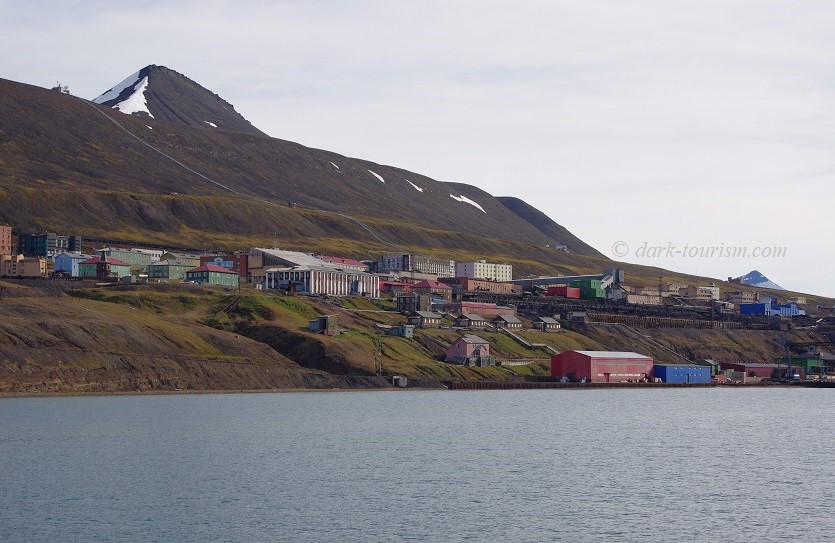
We docked at the jetty and were handed over to a Russian guide working for Arktikugol. She gave us a short introductory talk and accompanied us up the steep steps from the waterfront to the town as such. Here we were eventually given free time to explore on our own (that may well be different now!). Here’s a photo of the rather quiet main street of Barentsburg:
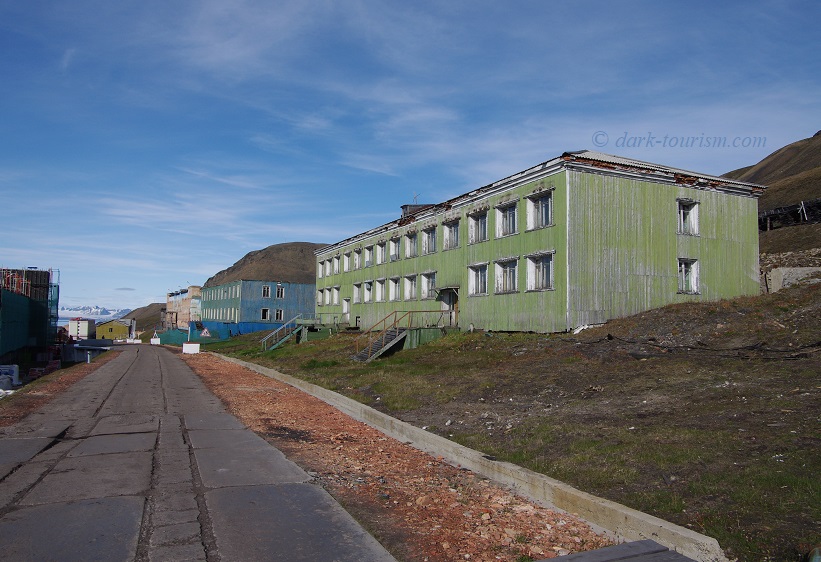
There are various murals in town, some quoting Arctic-exploration-glorifying poetry, another was simply a depiction of a birch forest, as you would frequently see in Russia:
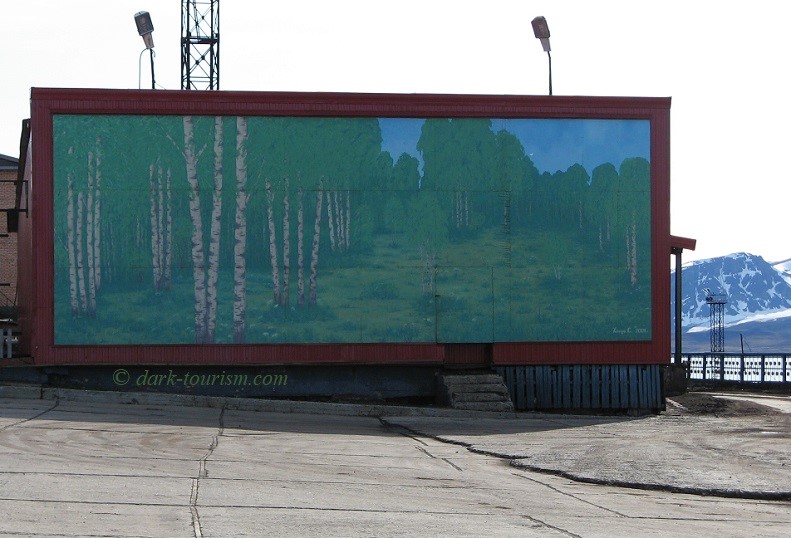
This must be seen as addressing Russian homesickness, as it were, since on Svalbard itself there are of course no trees, given its location in the high Arctic halfway between Norway’s northern coast and the North Pole.
During Soviet times the usual communist insignia were installed in its Svalbard outposts as well … and they are still there! In Pyramiden you can find the world’s northernmost Lenin bust (one of the many “northernmosts” that this place can lay claim to), but Barentsburg, located a bit further south, also still retains its prominent Lenin bust. More remarkably than that is the fact that behind that bust there’s still a full slogan from the Soviet communist era:
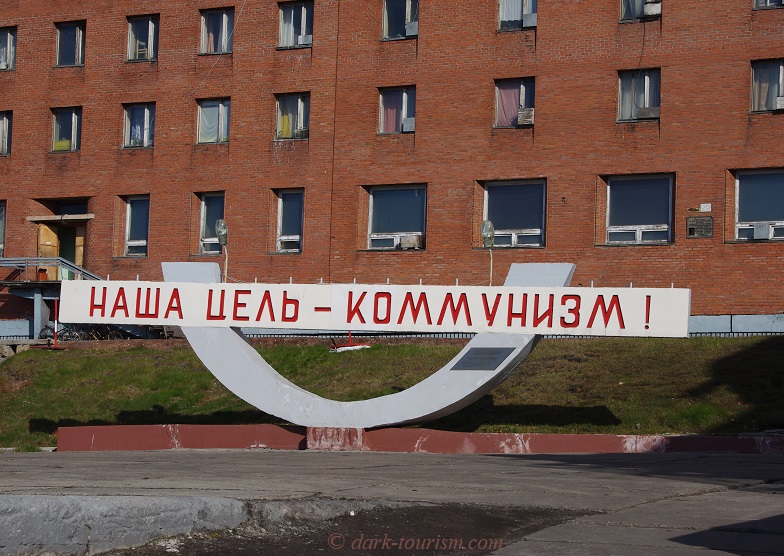
Literally this slogan translates simply as “our goal: communism!”. (That’s really quite ironic, given the current goals of Russia’s leadership, which are as far removed from communism as can be, except that the imperialistic aims of the old USSR seem to have been revived under Putin.) Almost nowhere else in the former Eastern Bloc would such a monument have survived intact, though in Russia old Soviet symbols, statues and slogans are still pretty common .. and so they are still here too.
Other hallmarks of “Russianness” includes the vehicles that can be encountered, as in this next photo:
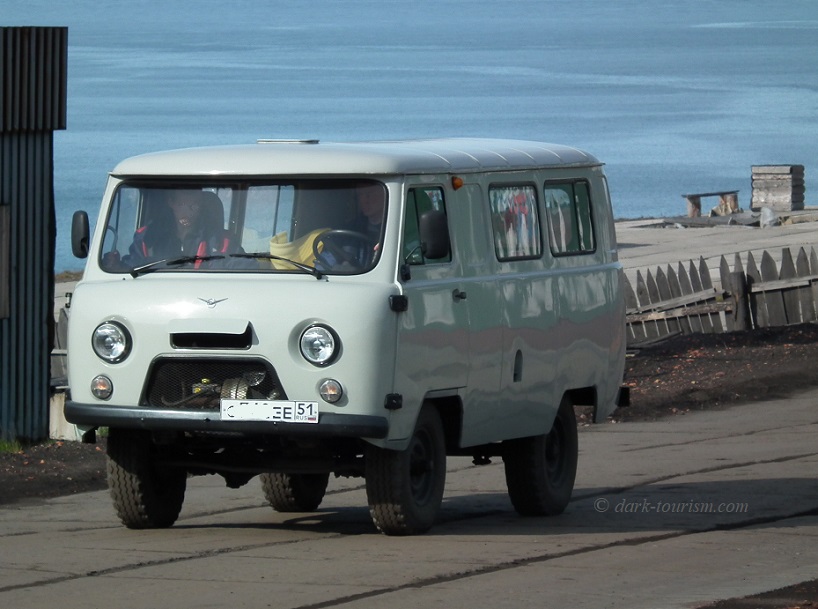
This is a UAZ 4×4 van, whose sturdiness is still much appreciated in the former Eastern Bloc, where you still see lots of them. Here in Barentsburg it was more of a surprise. Look closely and you can see the vehicle even bears a Russian Federation number plate (though I pixilated the actual numbers, but the flag is still visible).
Similarly, what you may see flying overhead can also be very Russian, such as the Soviet-era designed old helicopter that flew over Barentsburg while I was there, as seen in this next photo:
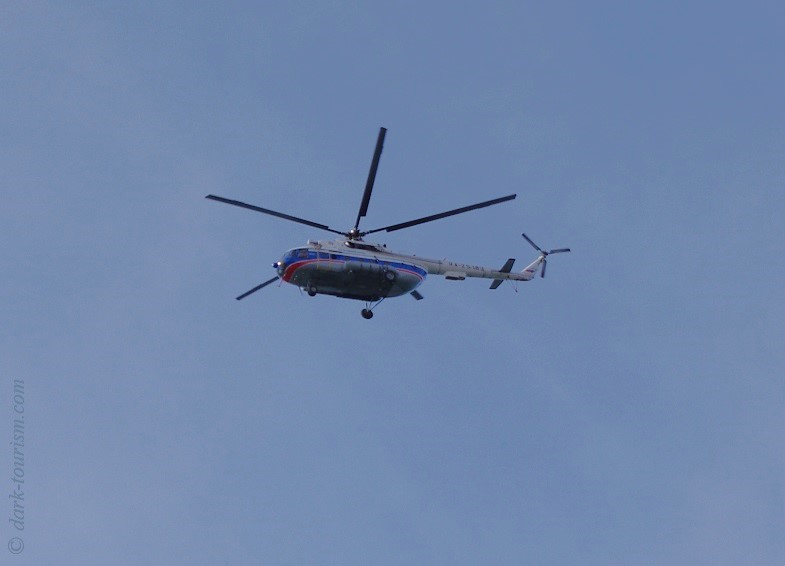
In a book about Svalbard that we picked on the tour this helicopter was funnily referred to as the “world’s best Russian helicopter” …. I loved the semantic skewed-ness of that label 😉 (as if there were more than one Russia in the world, each making helicopters, but none as good as this one …).
A main port of call for visitors to Barentsburg when I went was the bar (not least because drinks there, being subsidised and tax-free, are significantly cheaper than anywhere else in Norway). Here’s the entrance door with its intricate glass etching depicting Soviet symbols, coal mining operations and a polar bear:
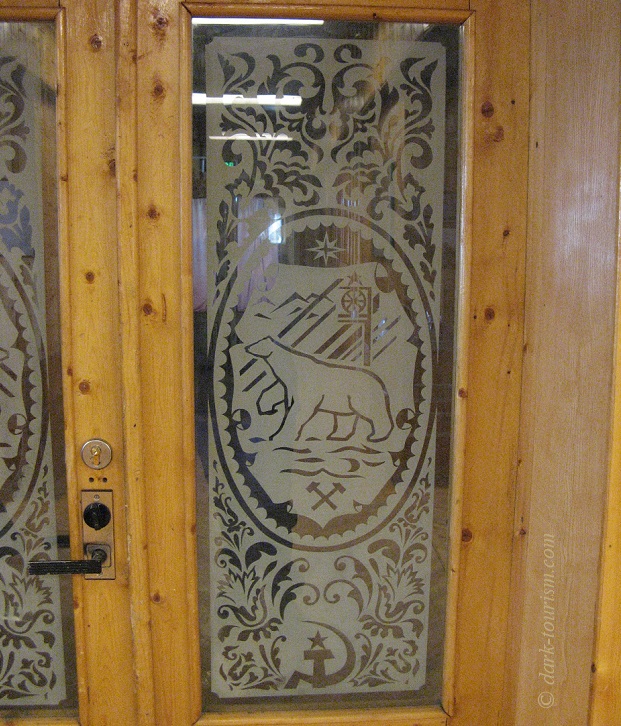
A few years after my visit in 2012 this regular Russian-style bar was joined by a craft-beer brewery & bar in Barentsburg, called “Krasniy Medved” (meaning ‘Red Bear’). Going by reviews it’s a rather American-type place with burgers, steaks, etc. and American style IPAs. (This is perhaps less surprising if you know that the craft beer scene had already been thriving in Russia itself). The latest review I could find, though, was from summer 2022. So I wonder whether that place is still in operation (maybe it was deemed too American?). By the way, the “Red Bear” used to be the northernmost craft-beer brewery in the world, until a few years later another such operation opened in Longyearbyen, which is a tad further north still.
How much future coal mining on Spitsbergen/Svalbard still has is uncertain, as the example of Pyramiden and other former, now abandoned Russian mining settlements show … Barentsburg may eventually follow suit when its mines are given up.
There are already certain signs of dereliction in the town. My favourite was this closed door with the stairs in front missing:
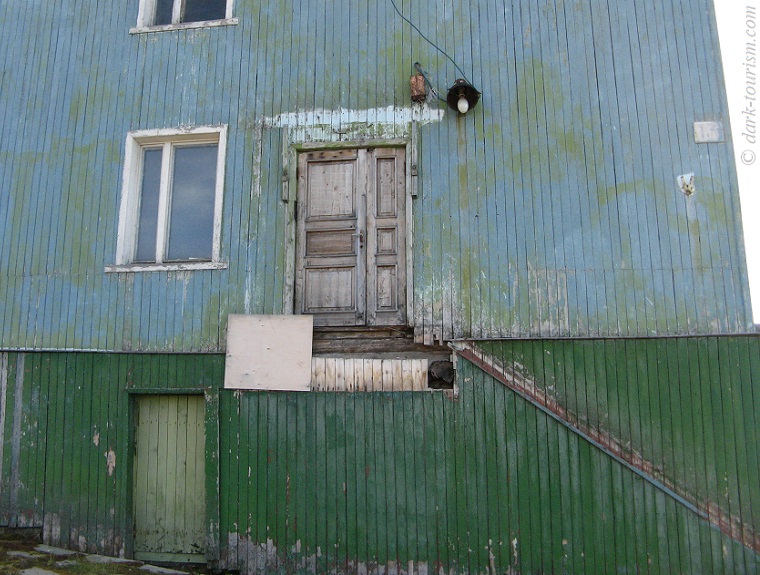
Yet Russia will probably focus on developing tourism to its two settlements that are still maintained. There are now also options for staying overnight in hotels, both at Barentsburg and in Pyramiden.
Some scientific work will most likely also continue, e.g. at this pretty old Russian-style wooden building on the edge of Barentsburg that houses the local branch of the Russian Academy of Sciences:
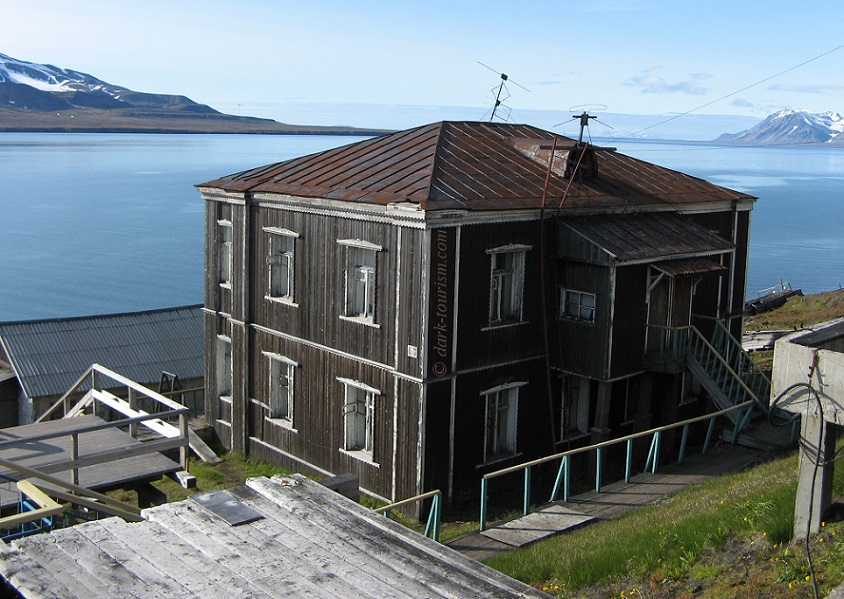
But with that let’s move on to the other place I had read about and that I had also visited as part of my 2012 Norway trip: Kirkenes.
Kirkenes is the north-easternmost town of Norway, by the Barents Sea and very close to the border with Russia, formerly the Soviet Union, at a time when this was in fact the only place in the world where a NATO member had a direct border with Russia (the only other NATO border with the USSR was on the edge of the Caucasus where Turkey bordered the USSR directly, namely Armenia and Georgia, so outside Russia).
The town of Kirkenes is an outpost but also of strategic and economic importance. Since the dissolution of the Soviet Union, relations between Russia’s extreme north-west and the Norwegian town of Kirkenes and the region it lies in were actually quite good. There was a lot of cross-border traffic and trade that was beneficial for both sides. I saw Russian market stalls selling cheap stuff to Norwegians while the Russians stocked up on things harder to find on the Russian side of the border. This will now be largely over, or at least be made much more difficult.
A clear sign of the cordial relations with Russia that I found in Kirkenes was the fact that e.g. its street names were in both Latin and Cyrillic script, as in this example:
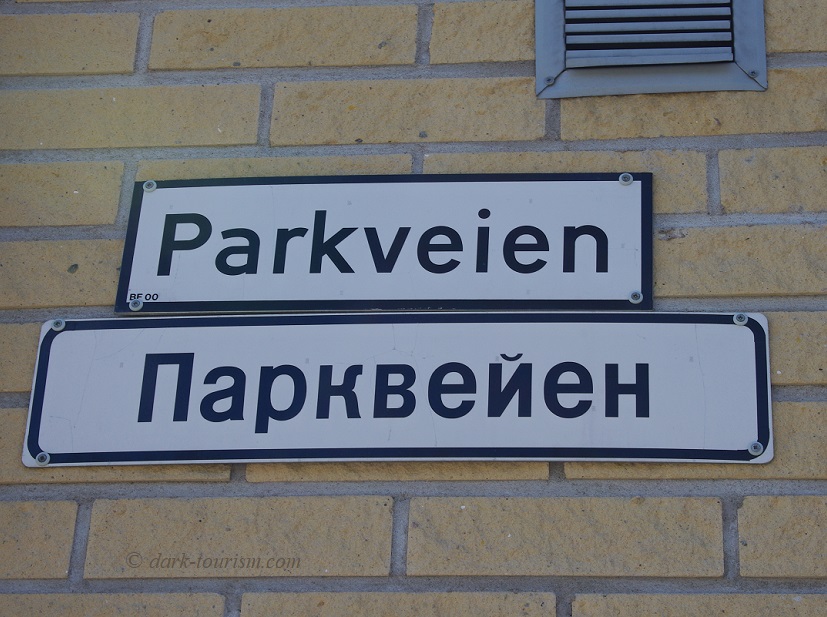
I also spotted a Russian bear sculpture, seemingly climbing up a pole and reaching for the sky (actually it was a hammer-and-sickle symbol atop the pole, out of the frame here, that the bear reached for!):
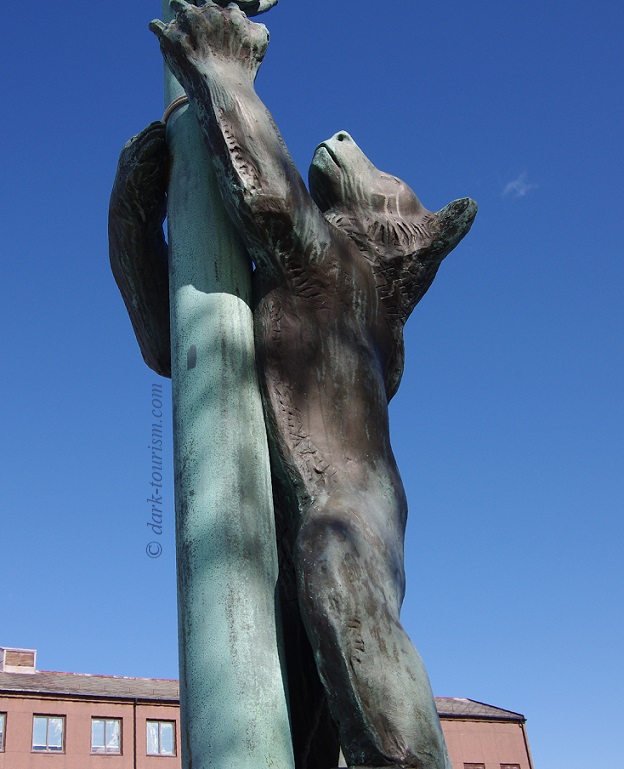
There’s also a Russian war memorial right in Kirkenes and that seemed well-looked-after in 2012, with a fresh wreath in Russian national colours:
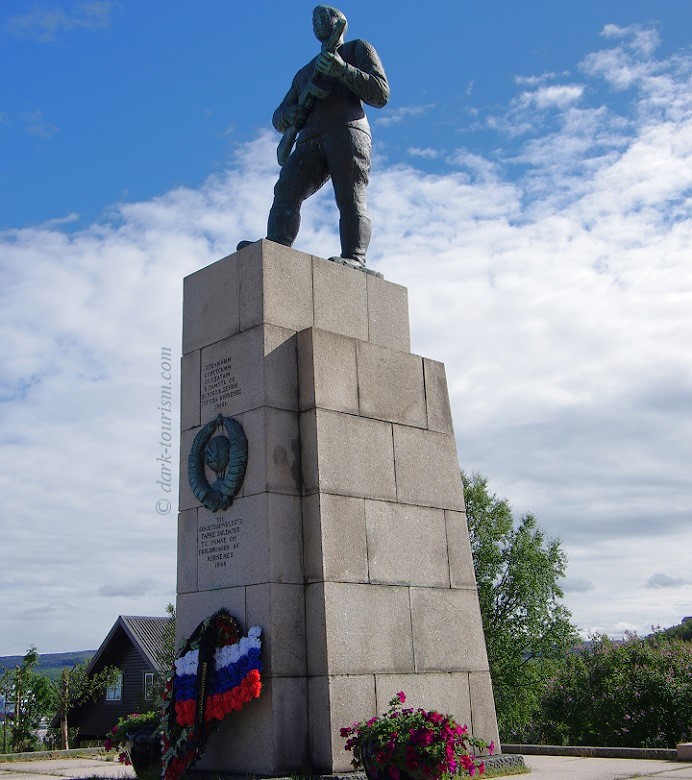
This monument commemorates the Red Army’s role in the eventual liberation of the Kirkenes region from Nazi Germany during WWII – for which Kirkenes paid a high price, though, as virtually the entire town was flattened during air raids. Hence there are hardly any old buildings to be found here; everything is modern/post-war. (But you can also visit some of the former WWII-era underground air-raid shelters.)
I also explored beyond Kirkenes itself and drove to the very border with Russia (by expensive hire car). Here is an example of a place where you can see the border river and a Russian border marker pole on the opposite riverbank:
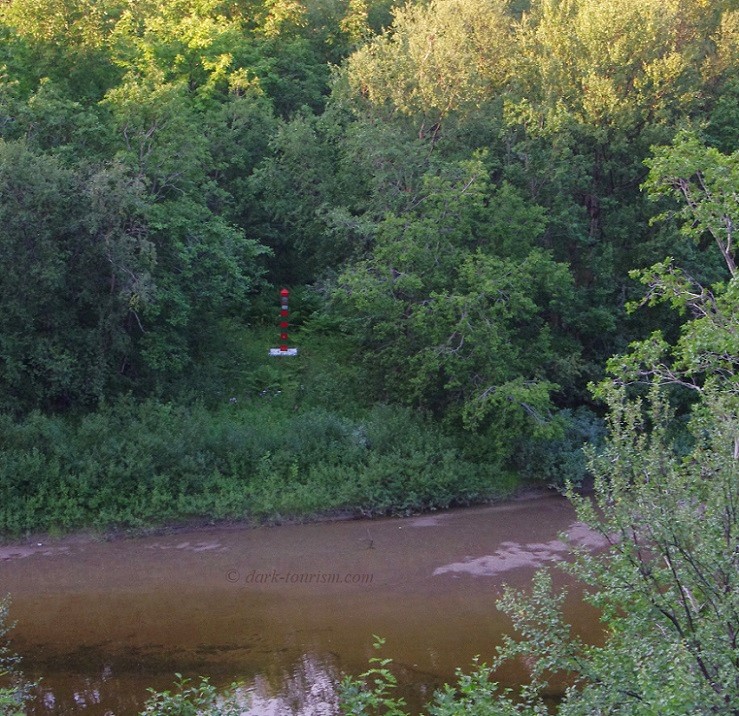
Dotted along the border on the Norwegian side are signs pointing out the borderland rules to be followed here, e.g. no wading in the shallow river, let alone crossing to the other side, no fishing, no use of long-lens photography, etc.).
This is in an area called Grense Jakobselv. It is now uninhabited but there’s still a church that remains in use:
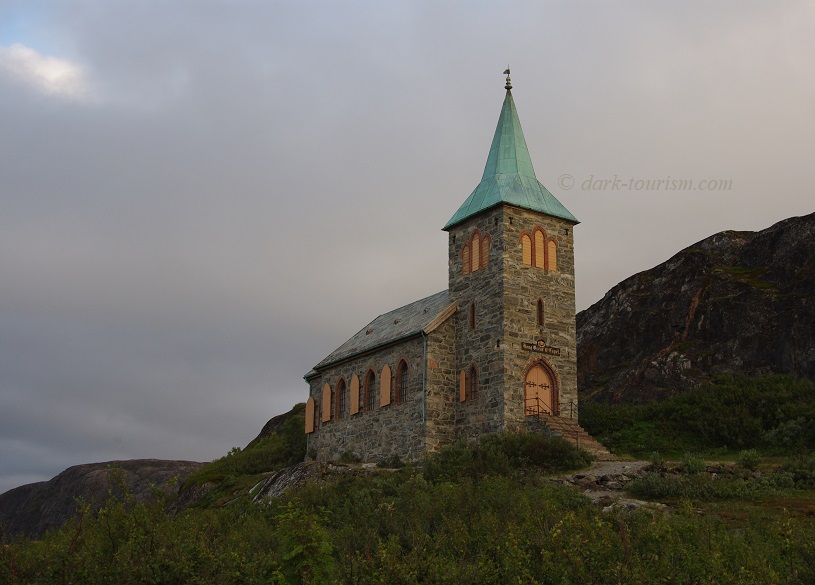
This building serves as much its religious purposes as that of being a marker of Norwegian sovereignty and territorial claims in this remote corner of the world.
All along the border you can also spot border-guard watchtowers, on both sides. Here’s a particularly tall one on the Russian side, seen from Grense Jacobselv:
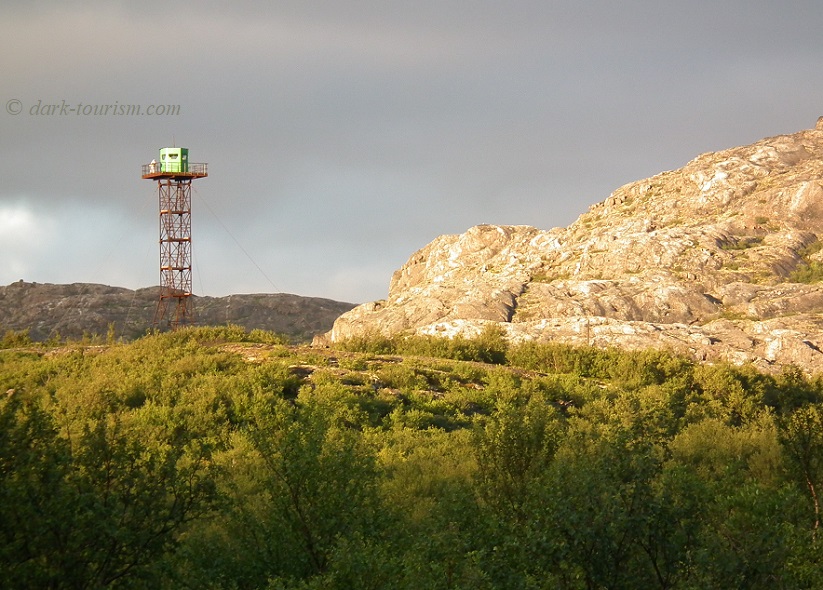
If you look closely you can make out at the top the figure of what seems to be a border guard keeping a watch over the land. I, illicitly but discreetly, used my then bridge camera’s 42x zoom to get a better view and discovered that the apparent border guard at the top was actually just a dummy in thermal clothes, just tied to the railing – a bit like a scarecrow (same photo as the featured one at the top of this post):
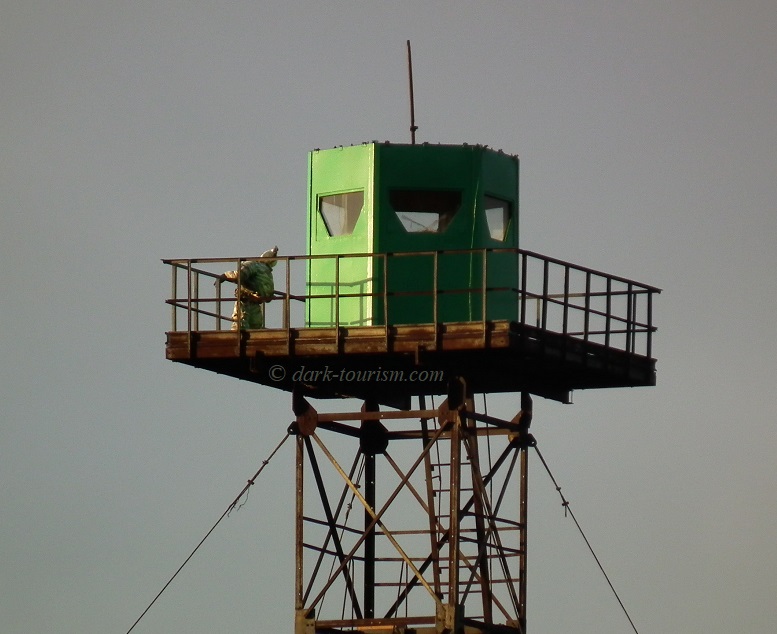
I also encountered some real border guards, on the Norwegian side, near the end of the road in Grense Jacobselv, where it reaches the shores of the Barents Sea. They were a pair of quite heavily armed conscript soldiers with a small military all-terrain vehicle. But they seemed very relaxed and friendly so I walked over and had a bit of a chat with them:
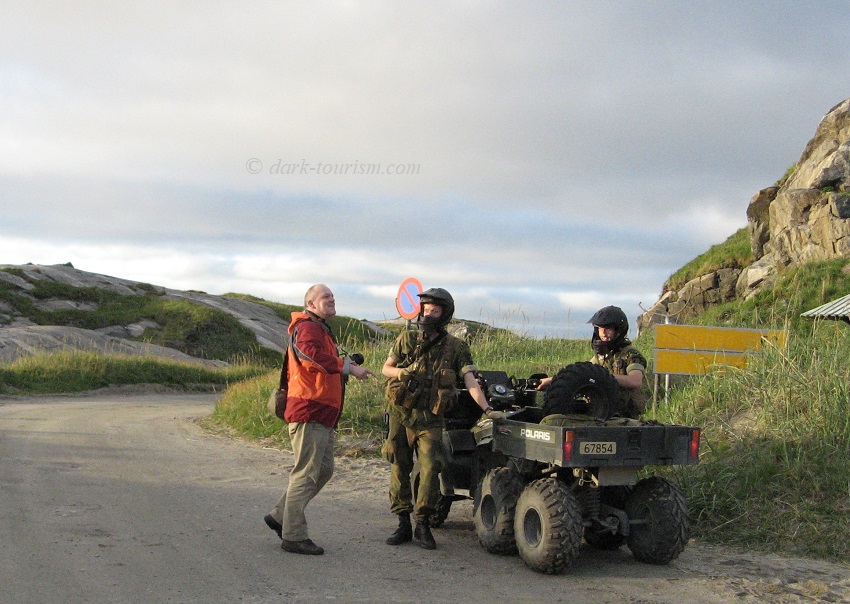
From them I learned that being stationed here during military service was back then seen as a lucky draw. It was peaceful and easy and you were surrounded by glorious northern landscape. They were certainly quite happy with it and there seemed to be no worrying tensions with their Russian counterparts. This may now have changed, and I could well imagine that conscripts are nowadays somewhat less keen to get posted here. But maybe I’m wrong. On a practical level, after all, the relations are still halfway workable. An attitude of getting along alright under the circumstances seems to be kept alive instead of escalating political tensions. As so often in the far north (or other extremely remote parts of the world), practicalities trump politics. Hence you can also still see Russian fishing trawlers in the harbour of Kirkenes, refuelling and stocking up on supplies. Though how much shore leave Russian fishermen/sailors get in Kirkenes these days I don’t know …
In 2012 when I was in the region I even ventured across this border with Russia for an overnight excursion to the mystical Arctic harbour metropolis of Murmansk, a few hours drive from Kirkenes. This was all legit and pre-organized, including transport (there by “marshrutka” public minibus, back by taxi), hotel accommodation in the city and the obligatory Russian visa … It was in fact quite an extravagance to obtain this visa, which takes time, nerves and money (as anybody who has ever dealt with a Russian embassy/consulate knows), and on this occasion all that just for barely 24 hours in the country! Yet that too was a superb component of my trip in 2012 that I wouldn’t want to have missed out on. I won’t go into this part of the trip any further here, though, as it would lead too far off topic. But one more aspect relevant to the Russian-Norwegian border topic of this post is a look at the border fence from the Russian side, as in this final photo:
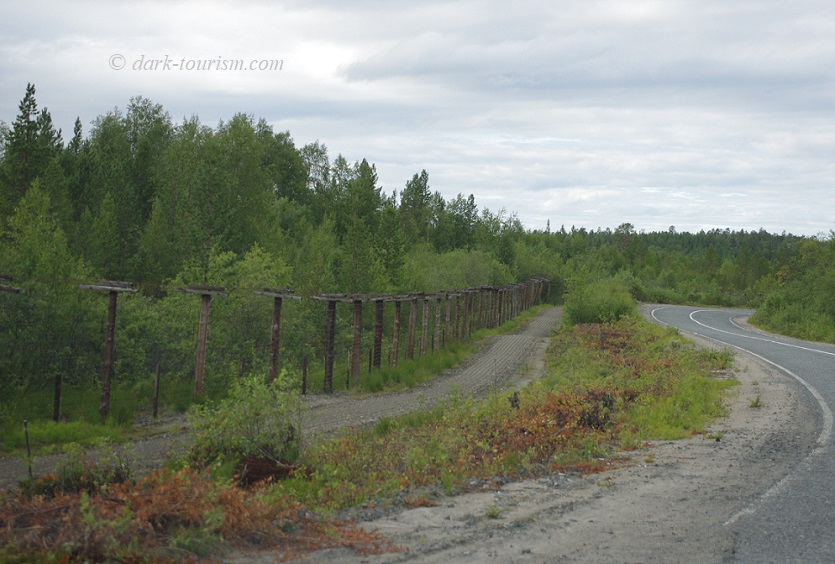
This part of the border still has more or less the same shape as the old Iron Curtain fence you can also still find in some other places in the world (e.g. in Armenia at the Ani viewpoint). I caught a glimpse of this from the car on the approach to the border crossing checkpoint en route back from Murmansk to Kirkenes.
I’m glad I did this back in 2012, as today such an excursion would probably no longer be possible (for a Westerner like me that is), or at least infinitely more complicated, for visa issue reasons alone.
So this is yet another travel memory I have to cherish because it could no longer be had today, in this conflict-ridden era … I just hope that all these conflicts can somehow be overcome and relations normalize … though how that should possibly be achieved in the current political and military climate is beyond me. Yet it would be great if travel to these remarkable, remote northern destinations could again become as easy and normal as I experienced it back in 2012.
So much for this post. For the next Blog post I will try to find a topic that is more independent of ongoing troubles and current affairs.



